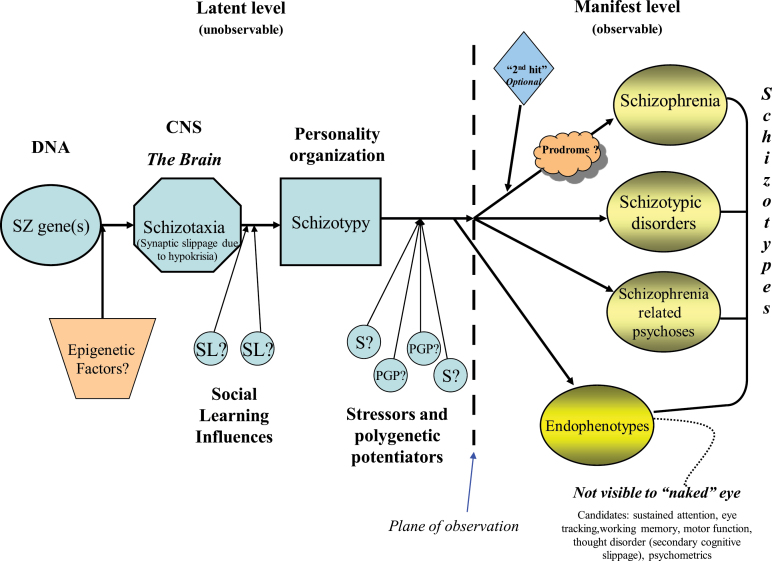Fig. 2.
Developmental model relating the genetic diathesis for schizophrenia, schizotaxia, and schizotypy and implied levels of analysis (inspired by Meehl7,8), with modifications by Lenzenweger4. Those factors to the left of the vertical broken line (ie, plane of observation) are “latent” and therefore unobservable with the unaided naked eye, whereas those factors to the right of the plane of observation are manifest (or observable). A DNA-based liability—primary synaptic slippage (embodied in Meehl’s hypothetical process denoted “hypokrisia”)—creates impaired CNS-based neural circuitry (schizotaxia) that eventuates in a personality organization (schizotypy) that harbors the liability for schizophrenia. Meehl7,8 viewed the genetically determined liability to be entirely taxonic in nature (ie, present or absent). However, this liability could also be determined by a confluence of genetic factors, probably many in number and of small effect, that have summed to pass a critical threshold (perhaps as many as 108 loci contribute to this liability, Schizophrenia Working Group of the Psychiatrics Genomics Consortium18). The “synaptic slippage” in this model is consistent with modern day concepts as diminished synaptic connectivity, abnormal connectivity, cognitive dysmetria, and so on. Social learning (SL) schedules interact with schizotaxia to yield schizotypy. Psychosocial stressors (S) and polygenic potentiators (PGP) interact with schizotypy to yield manifest outcomes across a range of clinical compensation. Various possible manifest developmental outcomes include schizophrenia (which may involve an optional “second hit,” eg, in utero exposure to maternal influenza), schizotypic psychopathology (eg, schizotypal and/or paranoid personality disorders), or schizophrenia-related psychoses (eg, delusional disorder). So-called “prodromal features” (withdrawal, reduced ideational richness, disorganized communication) may precede the onset of some (but not all) cases of schizophrenia. Endophenotypes (eg, sustained attention deficits, eye tracking dysfunction, working memory impairments, motor dysfunction, thought disorder (secondary cognitive slippage), and/or psychometric deviance (PAS); see Gottesman and Gould16), which are invisible to the unaided, “naked” eye (but detectable with appropriate technologies), are found below the plane of observation. Epigenetic factors refer to nonmutational phenomena, such as DNA methylation and histone acetylation (modification), that alter the expression of the schizophrenia gene (or genes). For example, there is the possibility that a hypermethylation process may serve to downregulate genes of relevance to schizophrenia. All individuals represented across this range of manifest outcomes are considered “schizotypes,” which does not necessarily imply an International Classification of Diseases (ICD) or DSM diagnosis. Finally, if there are genetically distinct variants of schizophrenia (Arnedo et al11), then each variant could follow a distinct developmental pathway comparable to that shown here but with different causal factors playing different roles across the variants. ©2010M.F. Lenzenweger, and used with permission.

